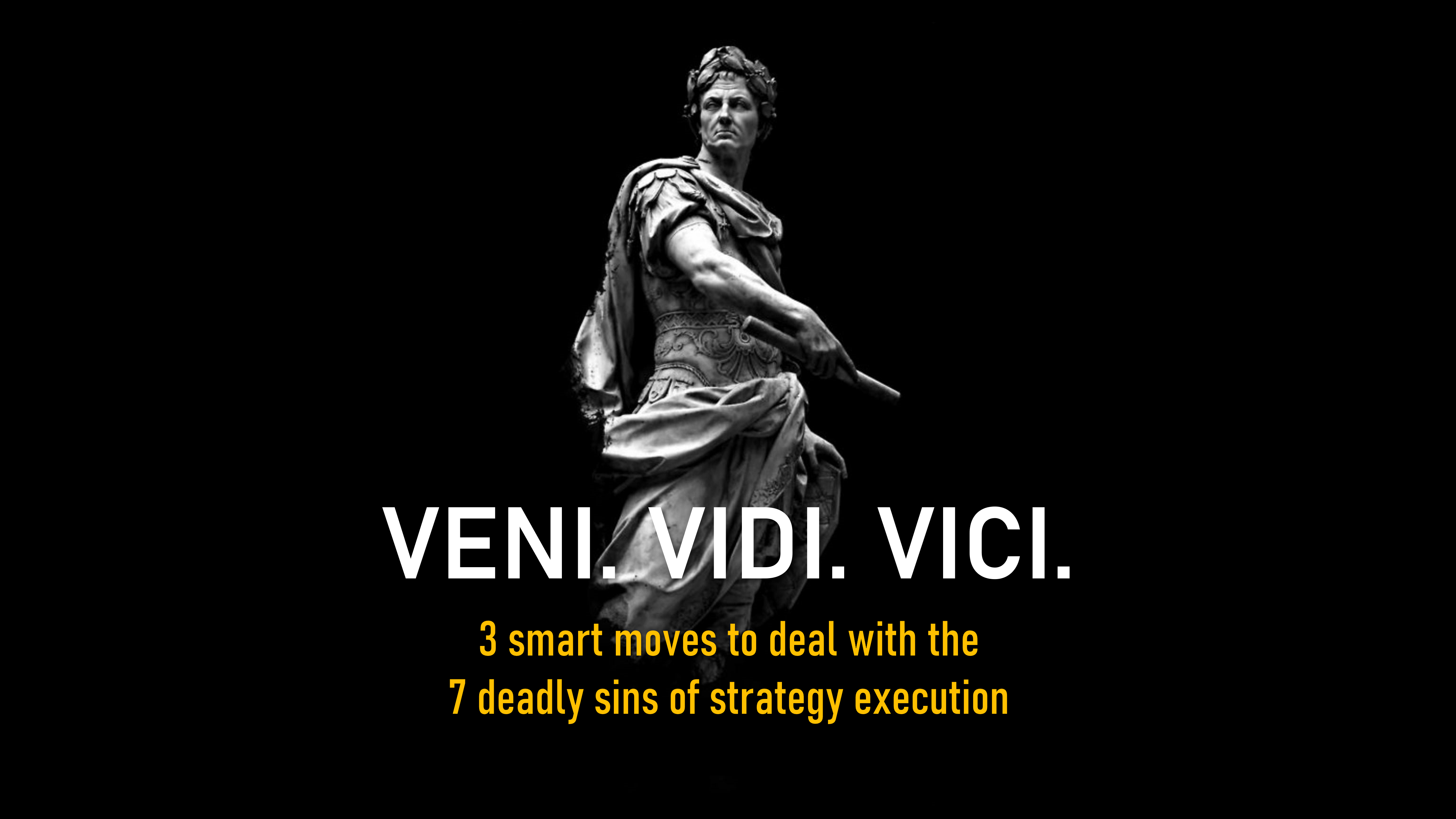
In their book “Exploring strategy” Johnson, Scholes & Whittington highlight 7 deadly sins that cause strategies to fail. Failing in a sense of lacking effective execution. Whereas the core task of any Executive Board is to create long-term value according to the 2016 European Corporate Governance Code. Looking at the root causes you may group them around 3 major topics, that relate to ‘level of detail’, ‘buy-in’ and ‘sticking to the plan’.
Sin #1: Death by Planning
An overemphasis on analysis and on planning the strategy rather than on delivering it, with the result that the organization never really gets into execution mode.
Sin #2: Disconnectedness
This happens when the strategy is purely based on top management’s perception of reality. Down-the-line managers and employees may face a very different reality, creating a disconnect.
What’s happening? Executive boards turn to the usual suspects for strategy. McKinsey, Bain & Co and alike. Those smart minds deliver valuable work, no doubt about it. But their plans lack one essential thing: execution power.
How come? Their strategic plans are not granular enough. They lack detail. Detail down to the level of projects and functionalities in combination with value-based prioritization is what you need to start immediate execution. This reminds me of some of my earlier engagements at Amsterdam Airport Schiphol where we were to deliver digital growth scenarios. Our input being a pile of 24 different strategic reports from all the big players in the market. Just saying.
During my time at Telfort/O2 I also came across another serious hazard: strategy consultants asking for a lot of time – time that comes on top of their regular jobs – from the people running day-to-day operations to collect their input. To never show their face again until presentation of the final strategy. Not the ideal way to get people on board to put it mildly. Set aside the value of a top-down, bottom-up approach to ensure a strategy that considers ‘the expert view’. It does a lot for strategy buy-in as well.
What’s the solution? Your secret weapon is a strategic customer journey map. It comes with a lot of benefits. It gives you clear insights into the customer journey, your own contact strategy supporting that same customer journey as well as omissions, pain points and opportunities.
With regards to opportunities: stakeholders from all functional business units in one single room is a recipe for interesting discussions and boils down to a journey and roadmap everybody can commit to. Especially in larger organizations it turns out people from different departments may not talk to each other in daily life. The journey map is also the basis for project prioritization. Business case- and value-based. Enabling you to drive business results in the short term.
Sin #3: Loss of Focus
Executing a strategy takes time and continuous effort. After the big bang introduction, attention to the strategy erodes while everyone is returning to business as usual.
Sin #4: Misreading Resistance
Employees are blamed for resisting the change, while in fact something else is going on. Often, the strategy is simply not clear enough or its reasons are not explained.
Sin #5: Reinterpretation
People adopt the terminology used in the new strategy but use it to describe what they already were doing. The effect is that there is no real change.
Sin #6: Behavioural Compliance
People literally do what is asked from them without really buying into the new strategy. They keep up appearances and tick the necessary boxes, but don’t embrace the strategy.
What’s happening? What sins #3-6 have in common is a lack of proper strategy onboarding in the wider organization.
How come? Something I see lacking in lots of organizations over the years is for the Executive Board to realize they have a long journey behind them once the strategy is approved by the General Meeting of Shareholders. While the organization is a blank canvas. At once confronted with a new reality.
The executive board used the time to design a well-founded strategy. With numerous meetings, workshops, discussions back and forth for months or even longer while getting advice from the Supervisory Board. For the people in the organization it is supposed to be love at first sight. The strategy being unfolded during a townhall meeting. For the people who must make the strategy work, though, it has big impact. With customer experience as the standard, new strategy often involves digital transformation. And digital transformation means: changing roles, new roles being created, change of processes and procedures, new ways of working. And that arouses uncertainty. With people potentially digging their heels in the sand.
What’s the solution? To manage the turnaround for the better an internal communication program works wonders. Yes, an official kick-off by the CEO and ones peers on the board, including timelines and top-level metrics to monitor progress. Likely multiple sessions for different time zones or areas. An internal campaign to support it and to keep the vibe alive. Leaders in Marketing, Sales, Customer Services, Operations, ICT, and HR to cascade it down to what it means for their teams specifically. And putting together a team, headed by a program manager to monitor progress of the strategy roll-out roadmap overall. No cost, but euros well-worth invested.
Sin #7: Broken agreements
Management promotes the strategy in words but undermines it with what they do. They violate trust and credibility by not acting along the lines of the strategy.
What’s happening? Personally, I have never encountered such situation in neither one of my jobs and client engagements. I can imagine, though, it may occur when short-term results are under pressure. When I come to think of it: something like this has happened for quite some years now with companies striving for customer experience. Long term. While putting a strong focus on sales activation. Short term.
How come? Running a business is all about return on investment. Keeping revenues and costs in balance. Promises to investors and shareholders, while the Executive board is also to observe the interest of other stakeholders. Apparently and obviously the short-term levers are easiest to pull. Sales activation and cost and budget cuts in times of an anticipated recession are still the tools to cling on to.
What’s the solution? In essence, once you decided on a specific strategy you stick to the plan. Even in rocky waters. And clear the misperception that customer experience is only a long-term money maker. Yes, it is. Nevertheless, with a smart, value-based implementation roadmap short-term return is up for grabs. Creating shareholder value in both the short- and long-term. Also, granting yourself the time and incremental budget to utilize the capabilities of marketing technology. The true value surfaces when you start adding new automated campaigns to enrich the customer experience. Thus, preventing yourself from substantial divestments and stepping into the next RFP cycle with history likely to repeat.
Strategy execution is a complex operation for sure. But with the right approach you can turn the odds in your favour.
